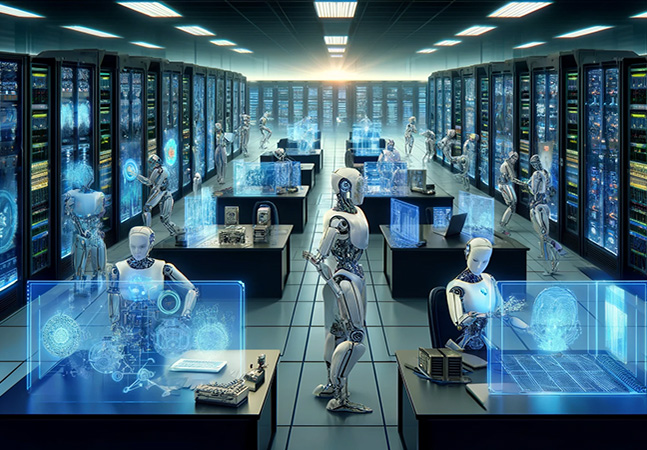-

Microsoft announced agent debugging functionality for Microsoft 365 Copilot directly from the AI tool itself, no Visual Studio 2022 or Visual Studio Code needed.
04/10/2025
-

GitHub chose Microsoft's 50th anniversary to highlight a bevy of Copilot enhancements that further the practice of "vibe coding," where AI does all the drudgery according to human supervision.
04/07/2025
-

Microsoft had a great thing going when it had GitHub Copilot all to itself in Visual Studio and Visual Studio Code thanks to its ownership of GitHub, but that's eroding.
04/07/2025
-

Agent Mode provides an autonomous editing experience where Copilot plans and executes tasks to fulfill requests. It determines relevant files, applies code changes, suggests terminal commands, and iterates to resolve issues, all while keeping users in control to review and confirm actions.
04/04/2025
-

Dr. James McCaffrey from Microsoft Research presents a complete end-to-end demonstration of the linear support vector regression (linear SVR) technique, where the goal is to predict a single numeric value. A linear SVR model uses an unusual error/loss function and cannot be trained using standard simple techniques, and so evolutionary optimization training is used.
04/01/2025
-

Microsoft's latest Visual Studio preview facilitates "vibe coding," where developers mainly use GitHub Copilot AI to do all the programming in accordance with spoken or typed instructions.
03/26/2025
-

Blazor creator Steve Sanderson presented a keynote at the recent NDC London 2025 conference where he previewed the future of .NET application development with smaller AI models and autonomous agents, along with showcasing a new Blazor voice assistant project demonstrating cutting-edge functionality.
03/25/2025
-

AI powerhouse NVIDIA flexed its muscle at its GTC 2025 conference this week where several partnerships with Microsoft were announced, mostly concerning Microsoft's Azure AI Foundry offering.
03/21/2025
-

Microsoft's VS Code dev team rides the vibe.
03/20/2025
-

According to the release notes, however, most dev-team attention was devoted to small fixes, features and functionality, as was the case in Preview 1, which shipped a few weeks ago.
03/19/2025
-

Dr. James McCaffrey from Microsoft Research presents a complete end-to-end demonstration of neural network quantile regression. The goal of a quantile regression problem is to predict a single numeric value with an assurance such as, "The predicted y value is 0.6789 and there's roughly a 90% chance the prediction will be greater than or equal to the true y value."
03/17/2025
-

Microsoft is expanding functionality for agentic AI into its Azure AI Foundry platform, furthering one of the hottest areas of development right now where AI controls computers just like humans.
03/13/2025
-

Things are happening quickly in the Microsoft-centric AI dev space, with the company previewing new AI features in Visual Studio 2022 ranging from a new .NET AI template to GPT-4o Copilot Code Completion.
03/12/2025
-

Continuing the journey from "AI pair programmer" to "autonomous peer programmer" to, eventually, just "AI programmer," no human coding needed, just supervision.
03/06/2025
-

With everyone scrambling to keep abreast of the rapidly advancing GenAI space, where some new tool or tech seems to be announced every week, Azure AI Foundry has emerged as a crucial end-to-end platform in the Microsoft-centric developer space.
03/06/2025
-

Some developers complained that advanced AI models come sooner to VS Code than Visual Studio, but the new Claude Sonnet 3.7 model is now available in IDE with a paid GitHub Copilot account and a simple settings tweak in GitHub.
03/05/2025
-

With agentic AI now firmly established as a key component of modern software development, Microsoft graduated its Semantic Kernel Agent Framework to Release Candidate 1 status.
03/04/2025
-

Dr. James McCaffrey from Microsoft Research presents a complete end-to-end demo of Poisson regression, where the goal is to predict a count of things arriving, such as the number of telephone calls received in a 10-minute interval at a call center. When your source data is close to mathematically Poisson distributed, Poisson regression is simple and effective.
03/03/2025
-

New Vision support with GitHub Copilot in the latest Visual Studio Code Insiders build takes a user-supplied mockup image and creates a web page from it in seconds, handling all the HTML and CSS.
02/20/2025
-

Dr. James McCaffrey from Microsoft Research presents a complete end-to-end demonstration of the naive Bayes regression technique, where the goal is to predict a single numeric value. Compared to other machine learning regression techniques, naive Bayes regression is usually less accurate, but is simple, easy to implement and customize, works on both large and small datasets, is highly interpretable, and doesn't require tuning any hyperparameters.
02/20/2025
-

The 4o upgrade includes additional training on more than 275,000 high-quality public repositories in over 30 popular programming languages, said Microsoft-owned GitHub, which created the original "AI pair programmer" years ago.
02/19/2025
-

Just after expanding the reach of its Copilot AI coding assistant to the open-source Eclipse IDE, Microsoft showcased how it's going even further, providing details about a preview version for the Xcode IDE from archrival Apple.
02/19/2025
-

Catering to Java jockeys, Microsoft is yet again expanding the sprawling reach of its Copilot-branded AI assistants, previewing a coding tool for the open-source Eclipse IDE.
02/13/2025
-

New GitHub Copilot AI features range from AI-enhanced feature search to edits across files, new shortcuts and expansion of slash commands, along with much more.
02/12/2025
-

At the upcoming Visual Studio Live! conference in Las Vegas, Marcel de Vries, Global MD & CTO at Xebia, will present a session on how developers can leverage Semantic Kernel to build AI-enhanced applications with C#.
02/11/2025